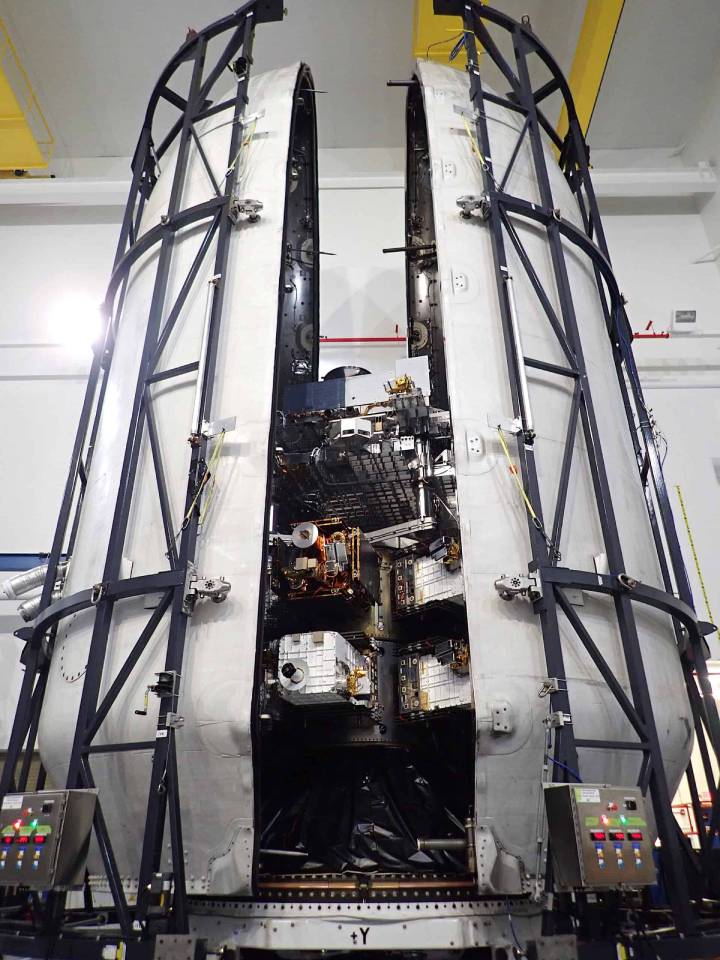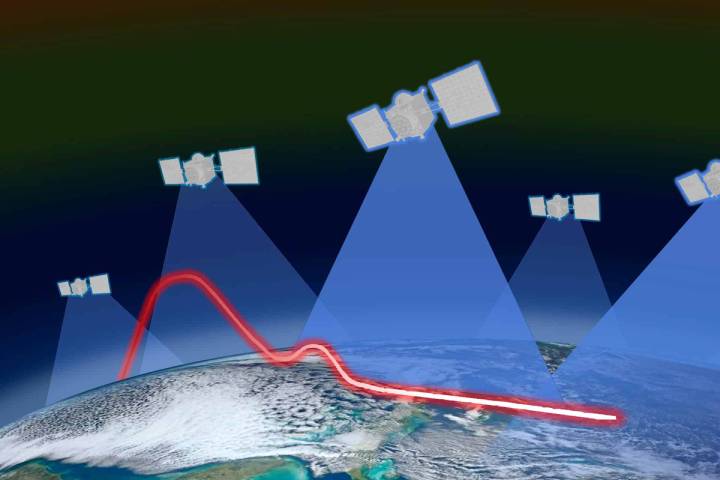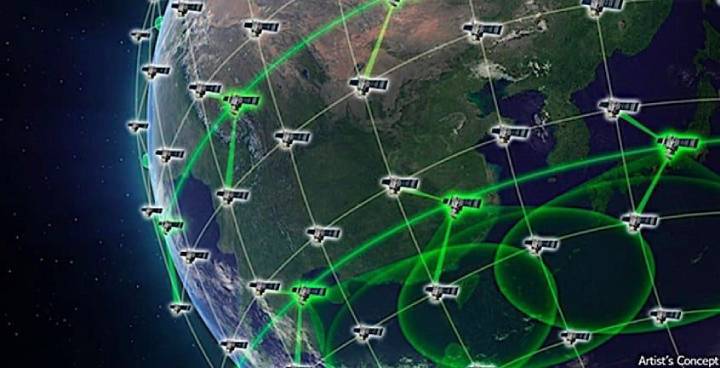 SDA Tranche 0 satellites being encapsulated inside a SpaceX Falcon 9 fairing. (Source: U.S. Space Development Agency)
SDA Tranche 0 satellites being encapsulated inside a SpaceX Falcon 9 fairing. (Source: U.S. Space Development Agency)
LA PLATA, Maryland — The Sept. 2 launch of 13 U.S. Space Development Agency (SDA) satellites leaves brings to 23 the number of Tranche 0 Transport and Tracking spacecraft in orbit, with four more to launch later this year. One will remain on the ground as a testbed.
All these missile detection and tracking satellites are equipped with optical communications terminals (OCTs), which SDA has repeatedly said is a key development goal for its Proliferated Warfare Space Architecture.

Group A (SVA): 13 mesh node satellites equipped with two optical communications terminals (OCTs) each & radio frequency (RF) receive/transmit capability.
Group B (SVB): 7 satellites, with SVA configuration, plus tactical data link (TDL) receive/transmit capability. Tracking: 8 satellites equipped with the wide field of view (WFOV) sensor payload and two OCTs each.
(Source: Space Development Agency)
Tranche 0 is designed to test these technologies as well as other satellite hardware that prime contractors York Space Systems, SpaceX, Lockheed Martin and L3 Harris have provided under separate SDA contracts.
But it remains unclear which companies’ terminals are aboard how many Tranche 0 satellites.
SDA hosted an Aug. 30 briefing ahead of the Sept. 2 launch, aboard a SpaceX Falcon 9 rocket, but did not clarify the issue despite the importance of OCTs to SDA’s network.
The agency has become the de facto adjudicator of commercial OCT standards as it seeks to assure that each company’s design can communicate with all the others in SDA’s growing network in low Earth orbit.
Four OCT providers have been associated with SDA Tranche 0: Tesat Spacecom, CACI International’s SA Photonics, Mynaric and Skyloom Global, working with Honeywell.
SDA did not respond to a request for clarification about who’s OCTs are on the Tranche 0 spacecraft.
The lack of clarity has led to industry rumors about the health of the Tranche 0 batch launched in April, which carried 10 York-built satellites and two from SpaceX.
 (Source: U.S. Space Development Agency)
(Source: U.S. Space Development Agency)
Mike Eppolito, Tranche 0 program director, acknowledged the rumors but said they were caused by a misunderstanding of how SDA is testing the satellites once they are in orbit.
“As far as the satellites on the first launch goes, there have been a lot of questions about propulsion issues because we haven’t orbit-raised those satellites, at least on the York side,” Eppolito said. “That was always our intent, to get them on orbit, get those payloads checked out, be able to demonstrate everything at the insertion orbit, and orbit-raise them later. There’s a lot of speculation there, but it’s by design. Don’t read anything into that.
“As far as issues: We had a workmanship issue with one of the satellites. We expect that satellite to perform the mission at a more-limited capacity. But that’s the most significant issue we have had on the satellites at this point.”
For the 10 York and SpaceX satellites launched in April, SDA expects to be able to test their ability to communicate with each other using the SDA OCT standard “certainly by the end of the year,” Eppolito said. The same compatibility testing will be done several months later with the 13 satellites launched Sept. 2, he said.
DARPA’s four Blackjack satellites
Similar questions have been raised about the performance of four satellites launched in June for the U.S. Defense Advanced Research Projects Agency (DARPA) Blackjack program.
Here too, what may appear as a satellite that has suffered a propulsion issue could in fact be DARPA’s decision to perform several months of testing before raising the satellites to their operational altitude. DARPA did not respond to request for comment on the satellites’ health.
 DARPA’s Blackjack, now reduced to four satellites, all lauched in June. (Source: DARPA)
DARPA’s Blackjack, now reduced to four satellites, all lauched in June. (Source: DARPA)
“They were essentially a pathfinder for SDA’s architecture,” Jennifer Elzea, SDA’s director of strategic engagement, said during the briefing, referring to DARPA’s Blackjack. “We continue to stay in touch with them collaboratively. But we are moving forward with fielding our architecture at this point. I don’t have anything to say as far as their progress. You would need to check with DARPA on that.”
CACI International is providing four OCTs for each of the four DARPA Blackjack satellites. The company has said the terminals have been “operating at or above” specifications.
CACI also said it was a supplier on the SDA’s Tranche 0 program, as did Skyloom Global.
Mynaric has also been identified as a Tranche 0 OCT provider.
 Tesat Spacecom tweeted its role in SDA’s Tranche 0.
Tesat Spacecom tweeted its role in SDA’s Tranche 0.
High stakes for optical terminal providers as multiple commercial constellations decide on suppliers
For all four OCT manufacturers, and others developing similar technology for future SDA contracts, being able to say they have passed SDA’s interoperability requirements following testing at the U.S. Naval Research Laboratory is a valuable endorsement as they bid for commercial satellite constellations.
“There will be other entrants in the optical terminal market, and the point is to make sure that standard is out there so they can interoperate, Elzea said.
There are several commercial networks, each more than 100 satellites, whose owners are looking for OCT contractors. These include the OneWeb second-generation network; Telesat’s Lightspeed; Rivada Space Networks; and the European Commission’s Iris2 network, whose OCT bidders will be limited to European Union-registered providers.
Read more from Space Intel Report.
